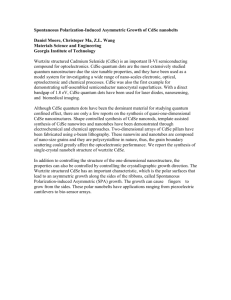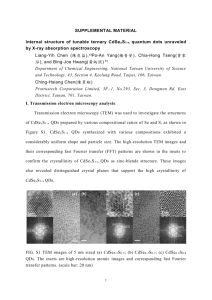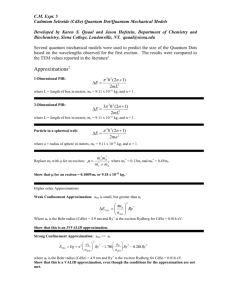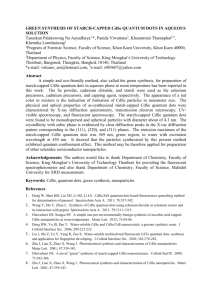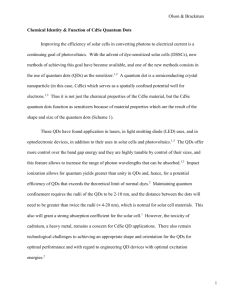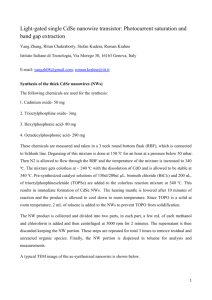L11-08096_Suppl_Revised
advertisement
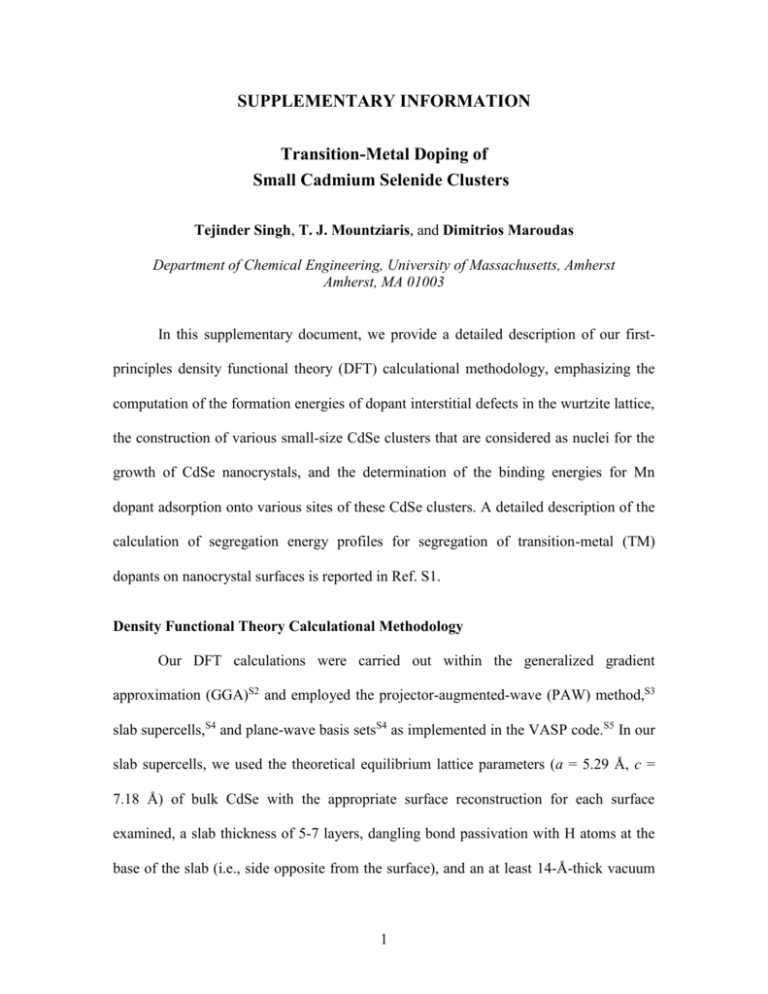
SUPPLEMENTARY INFORMATION Transition-Metal Doping of Small Cadmium Selenide Clusters Tejinder Singh, T. J. Mountziaris, and Dimitrios Maroudas Department of Chemical Engineering, University of Massachusetts, Amherst Amherst, MA 01003 In this supplementary document, we provide a detailed description of our firstprinciples density functional theory (DFT) calculational methodology, emphasizing the computation of the formation energies of dopant interstitial defects in the wurtzite lattice, the construction of various small-size CdSe clusters that are considered as nuclei for the growth of CdSe nanocrystals, and the determination of the binding energies for Mn dopant adsorption onto various sites of these CdSe clusters. A detailed description of the calculation of segregation energy profiles for segregation of transition-metal (TM) dopants on nanocrystal surfaces is reported in Ref. S1. Density Functional Theory Calculational Methodology Our DFT calculations were carried out within the generalized gradient approximation (GGA)S2 and employed the projector-augmented-wave (PAW) method,S3 slab supercells,S4 and plane-wave basis setsS4 as implemented in the VASP code.S5 In our slab supercells, we used the theoretical equilibrium lattice parameters (a = 5.29 Å, c = 7.18 Å) of bulk CdSe with the appropriate surface reconstruction for each surface examined, a slab thickness of 5-7 layers, dangling bond passivation with H atoms at the base of the slab (i.e., side opposite from the surface), and an at least 14-Å-thick vacuum 1 layer in the direction perpendicular to the slab surface. We performed structural relaxation for all the atoms in the slab supercell except for those at the bottom layer (from the surface). After performing careful convergence tests, we used for our calculations a kinetic-energy cut-off of 290 eV and a (2×2) k-point mesh in the irreducible wedge of the first Brillouin zone for integration in reciprocal space.S6 All of the calculations reported in this study were spin-polarized. To calculate the total energies of the relaxed atomic configurations (geometrically optimized configurations with the electrons in their ground state), we used a conjugate-gradient algorithm with convergence criteria that the difference in electronic and ionic self-consistent energy was smaller than 10-4 eV and 10-3 eV, respectively. The use of slab supercells for modeling surfaces of large nanocrystals (with diameters d ~ 5 nm) assumes that the nanocrystals have polyhedral shapes with welldefined facets, an assumption that is justified by experimental observations of CdSe nanocrystals with wurtzite lattice structure.S7-S9 Our DFT-based surface energy calculations confirm that the equilibrium crystal shape (ECS) of CdSe nanocrystals _ _ _ consists of low-Miller-index surfaces [(0001), (000 1 ), (10 1 0), and (11 2 0)]. During the growth of nanocrystals and in the ECS, the surface area of the nanocrystal facets is determined (as a result of free energy minimization for given nanocrystal mass) by the chemical potentials of the anionic/cationic precursors in the growth solution. Finally, it should be mentioned that nanocrystal growth occurs in solution and not in vacuum; however, the solvent molecules do not react with the nanocrystal surface and the pressure in the growth experiments is low (atmospheric). The slab supercell models used in this 2 study are consistent with these conditions and have been employed in other studies of nanocrystal doping that have been reported in the literature.S9 Calculation of Formation Energies of Dopant Interstitial Defects The formation energy, Ef, for a dopant impurity atom at an interstitial site in the bulk CdSe crystalline lattice is defined as E f Etot E pristine d , (S1) where Etot is the total energy of the bulk CdSe crystal with the dopant atom placed at an interstitial site of the wurtzite lattice, Epristine is the total energy of the pure CdSe crystal without the dopant atom, and d is the chemical potential of an isolated dopant atom. In the wurtzite lattice, we examined the stability of the three interstitial impurity configurations with the dopant atom at the H site (hexagonal site), the T site (tetrahedral site), and the bond center of the Cd-Se bond. Table S-I lists the formation energies of these three interstitial configurations and compares the results between bulk CdSe and ZnO crystals with wurtzite lattice structure. Table S-I: Computed formation energy, Ef, values for the Mn dopant impurity at various interstitial sites in the bulk CdSe and ZnO crystals with wurtzite lattice structure. Interstitial Sites Ef (eV) in bulk CdSe, Eq. (S1) Ef(eV) in bulk ZnO, Eq. (S1) H site -1.75 1.64 T site Bond Center -1.93 1.64 -0.48 Unstable The results of Table S-I imply that the T site is the most stable interstitial site for a Mn impurity in the CdSe and ZnO bulk crystals. The bond-center configuration is highly unstable as compared to that with the dopant at the T site and the H site of the bulk CdSe 3 crystal lattice. This is not surprising, considering the large covalent radius (~1.39 Å) of Mn that is comparable to half of the bond length in CdSe (1.34 Å). In the ZnO crystal, half of the bond length is only 1.0 Å and the Mn bond-center impurity configuration is highly unstable due to large steric repulsions. When a Mn atom is introduced in the ZnO lattice, it generates a very high lattice strain; this results in breaking of Zn-O bonds in the vicinity of the dopant atom, as shown upon DFT-based electronic and structural optimization.S1 Therefore, we conclude that the T site and the H site are stable Mn interstitial impurity sites in the bulk CdSe lattice and that their stability is significantly higher than that of the corresponding interstitial impurities in the lattice of the bulk ZnO crystal. Construction of Small CdSe Clusters In this Section, we describe the geometrical procedure that we have used in order to construct several small CdSe clusters, which represent nuclei for the growth of nanocrystals with wurtzite and zinc-blende lattice structures. Figure 1 of the main article shows various small CdSe clusters, with diameters ranging from 1 to 1.5 nm, which constitute nuclei for the growth of CdSe nanocrystals with wurtzite lattice structure. The smallest seed unit that can be cleaved from the bulk CdSe wurtzite lattice [Fig. 1(e) of main article] with the minimum number of surface dangling bonds is (CdSe)6 as shown in Fig. 1(a) of the main article. This (CdSe)6 cluster has both Cd and Se surface dangling bonds that are passivated with pseudohydrogen atoms. For each Cd and Se surface dangling bond, the charge on the pseudohydrogen atom is qH = 1.5 e and qH = 0.5 e, respectively [see, e.g., Ref. 22 of main article]. 4 The next-in-size cluster with the minimum number of surface dangling bonds that can be constructed from the CdSe wurtzite lattice is the (CdSe)9 cluster. The optimized configuration of the (CdSe)9 cluster with H passivation is shown in Fig. 1(b) of the main article. This (CdSe)9 cluster is constructed from the (CdSe)6 cluster in a manner that mimics the growth of the crystal in the axial (c-) crystallographic direction of the bulk crystal. In a similar manner, the third-in-size (CdSe)10 cluster [Fig. 1(c) of main article] is formed from the (CdSe)6 cluster when the crystal growth occurs in the “radial” direction. Finally, the largest-size cluster in this category that we analyzed is the (CdSe)13 cluster [Fig. 1(d) of main article], which is formed from the (CdSe)10 cluster mimicking the crystal growth in the radial direction. Using spectroscopic analysis, (CdSe)13 has been predicted to be an ultra-stable cluster (magic-size cluster) configuration.S10, S11, S12 In each of the clusters analyzed, the Cd-Se, Se-H, and Cd-H bond lengths vary from 2.65 to 2.70 Å, from 1.59 to 1.61 Å, and from 1.80 to 1.84 Å, respectively. In addition, for reference purposes, the bulk CdSe wurtzite lattice is shown in Fig. 1(e) of the main article. The range of diameters (1-1.5 nm) and size of these clusters (12-26 atoms, excluding terminating H atoms), in conjunction with certain comparisons made with bulk-crystal quantities, were sufficient to draw the conclusions of our study. Figure S1 shows various small CdSe clusters with diameters ranging from 0.6 to 1.8 nm that constitute nuclei for the growth of nanocrystals with zinc-blende lattice structure. The diameter of each of the CdxSex (x = 6, 9, 10, 13) clusters is calculated according to the equation d = V1/3, where V is the volume of the cuboid that encloses the CdSe cluster after its passivation with pseudohydrogen atoms. In experiments, the most 5 commonly used polynuclear transition-metal precursors for the doping of CdSe nanocrystals are characterized by anions of the form [Cd4Se10(SPh)16]4- or [Cd10Se4(SPh)16]4- [see, e.g., Refs. 14, 15, and 16 of main article]. Motivated by this, we also constructed the Cd4Se10 cluster [Fig. S1(b)] from the CdSe zinc-blende lattice. In this cluster, all the surface Se atoms are passivated with pseudohydrogen atoms with qH = 0.5 e. Figures S1(c) and S1(d) show the Cd10Se20 and Cd20Se35 clusters, which are formed from the Cd4Se10 cluster by self-similar growth in every principal crystallographic direction. The smallest seed unit for growing zinc-blende nanocrystals is the CdSe4 cluster, which also is depicted in Fig. S1(a). This cluster also is the smallest seed for growing nanocrystals with wurtzite lattice structure; however, we classify CdSe4 under the zinc-blende category because of the unequal numbers of Cd and Se atoms in this cluster. In all of the CdSe clusters that constitute nuclei for growing crystals with zincblende lattice structure, there are exactly four Se atoms that are terminated with 3 H atoms each, while the remaining Se atoms are terminated with 2 H atoms each. In these clusters, the Se-H and Cd-Se bond lengths vary from 1.58 to 1.60 Å and from 2.66 to 2.70 Å, respectively. Mn-Doped CdSe Clusters The equilibrium configurations of the pristine CdSe clusters that we examined as nuclei for growing nanocrystals with wurtzite lattice structure were discussed in the previous Section. These include the (CdSe)6, (CdSe)9, (CdSe)10, and (CdSe)13 clusters that range from 1 to 1.5 nm in diameter. In this Section, we present the DFT-optimized atomic configurations and the respective valence electron density (VED) distributions for these clusters both in their pristine state and after dopant adsorption onto them. Figures 6 S2-S5 show the equilibrium atomic configurations of the undoped and Mn-doped (CdSe)6 [Fig. S2], (CdSe)9 [Fig. S3], (CdSe)10 [Fig. S4], and (CdSe)13 [Fig. S5] clusters. (a) (b) 2.69 2.69 1.59 2.68 1.59 d ~ 1.00 (d) d ~ 0.62 (c) 2.68 2.67 1.59 2.69 1.60 2.68 d ~ 1.79 d ~ 1.38 Figure S1: Equilibrium atomic configurations of the (a) CdSe 4, (b) Cd4Se10, (c) Cd10Se20, and (d) Cd20Se35 clusters. Gold, light yellow, and white spheres denote Se, Cd, and H atoms, respectively. The approximate diameter, d, for all the CdSe clusters is given in nm. The numbers shown give the indicated interatomic distances (bond lengths) in Å. (CdSe)6 Cluster Figures S2(a) and S2(b) show the equilibrium atomic configurations of the _ (CdSe)6 cluster in its pristine state and after Mn adsorption onto its (000 1 )-Se-terminated and (0001)-Cd-terminated sides, respectively. Side and top views of the optimized atomic configuration of the (CdSe)6 cluster in its pristine state is shown in Figs. S2(a1) and S2(a3), respectively. The (CdSe)6 cluster has multiple sites available for dopant 7 adsorption. Given the geometrical approach followed for the cluster construction, the four most stable sites for Mn adsorption onto the (CdSe)6 cluster correspond to the _ _ _ equivalent binding sites on the low-Miller-index [(0001), (000 1 ), (10 1 0) and (11 2 0)] _ surfaces of the bulk CdSe crystal. For example, on the bulk-terminated CdSe(000 1 ) surface terminated with Se atoms, the most stable binding site for Mn adsorption is at the center of the triangle formed by three surface Se atoms. As overgrowth proceeds, this site corresponds to the H interstitial site in the bulk CdSe lattice. Similarly, side and top views of the optimized configuration with one Mn atom adsorbed onto the most stable binding site (which becomes upon further crystal growth the H site of the interstitial _ space of the bulk crystal lattice) on the CdSe(000 1 )-Se-terminated surface of the (CdSe)6 cluster is shown in Figs. S2(a2) and S2(a4), respectively. The corresponding VED maps in Figs. S2(a5) and S2(a6) highlight the charge density distributions for the pristine cluster and the doped cluster, in the vicinity of the Mn dopant atom after its adsorption onto the cluster, respectively. In a completely analogous manner, Figs. S2(b1) and S2(b3) show side and top views of the optimized atomic configuration of the pristine (CdSe)6 cluster before Mn dopant adsorption onto the _ CdSe(000 1 )-Cd-terminated surface. It should be noted that the structure in Figs. S2(a1) and S2(b1) is the same (CdSe)6 pristine cluster except that it is rotated by 180° for aid in its visualization. Figures S2(b2) and S2(b4) depict the optimized structures of the cluster with the dopant atom adsorbed onto the site that corresponds to the most stable binding site on the CdSe(0001)-Cd-terminated surface. 8 (a) (1) 1.60 (2) (b) 2.48 (1) (2) 2.72 1.85 1.60 2.68 2.68 1.85 1.85 (3) 1.60 (4) (3) 2.65 (4) 2.65 2.48 Se 2.68 2.68 Se Mn Se 2.78 Se 2.72 Cd (6) (5) Cd Cd Se Se 2.77 Cd (6) (5) Mn Se Mn Mn Se Cd Cd Cd Cd Figure S2: Equilibrium atomic configurations showing side and top views of the (CdSe) 6 cluster in its pristine state and after Mn adsorption onto the cluster for the (a) Se-terminated side and (b) Cdterminated side. Gold, light yellow, white, and purple spheres denote Se, Cd, H, and Mn atoms, respectively. The numbers shown give the indicated interatomic distances (bond lengths) in Å. The panels depict (1) the side and (3) the top view of the optimized configuration of the pristine (CdSe)6 cluster; (2) the side and (4) the top view of the optimized configuration of the (CdSe) 6 cluster with a Mn dopant atom adsorbed onto it; and the valence electron density (VED) distribution for (5) the pristine cluster and (6) the doped cluster in the vicinity of the dopant atom. In (5), the VED map is shown on the plane defined by the two marked Se or Cd atoms and a third point that will become the geometrical location of the dopant atom upon its adsorption onto the cluster. In (6), the VED map is shown on the plane defined by the marked Se, Mn, and Se or Cd, Mn, and Cd atoms labeled in each panel. In each VED map, the iso-VED contour lines also are plotted. The corresponding VED maps, shown in Figs. S2(b5) and S2(b6,) highlight the atomic bonding strengths for the pristine cluster and for the doped cluster in the vicinity of the adsorbed Mn dopant atom, respectively. In the following subsections, the corresponding equilibrium atomic configurations are shown for the (CdSe)9, (CdSe)10, and (CdSe)13 clusters both in their pristine state and after Mn adsorption onto them in a manner similar to those of the (CdSe)6 cluster reported above. 9 (CdSe)9 Cluster (a) (1) 1.60 (2) 1.85 1.85 Se (3) 2.47 Se Mn Se Se (4) 2.66 Cd Cd Cd Mn (6) (5) Cd Mn Se 1.59 2.79 Cd (6) (5) 2.68 1.60 (4) 2.79 (2) 2.66 2.68 2.66 Se 1.85 2.68 2.67 (3) (1) 2.68 2.68 2.68 (b) 2.47 Se Mn Cd Cd Se Cd Figure S3: Equilibrium atomic configurations showing side and top views of the (CdSe)9 cluster in its pristine state and after Mn adsorption onto the cluster for the (a) Se-terminated side and (b) Cdterminated side. Gold, light yellow, white, and purple spheres denote Se, Cd, H, and Mn atoms, respectively. The numbers shown give the indicated interatomic distances (bond lengths) in Å. The panels depict (1) the side and (3) the top view of the optimized configuration of the pristine (CdSe) 9 cluster; (2) the side and (4) the top view of the optimized configuration of the (CdSe) 9 cluster with a Mn dopant atom adsorbed onto it; and the valence electron density (VED) distribution for (5) the pristine cluster and (6) the doped cluster in the vicinity of the dopant atom. In (5), the VED map is shown on the plane defined by the two marked Se or Cd atoms and a third point that will become the geometrical location of the dopant atom upon its adsorption onto the cluster. In (6), the VED map is shown on the plane defined by the marked Se, Mn, and Se or Cd, Mn, and Cd atoms labeled in each panel. In each VED map, the iso-VED contour lines also are plotted. 10 (CdSe)10 Cluster (a) (1) (2) 1.59 2.48 1.60 2.68 2.68 1.85 1.84 (3) (4) 2.68 Se 2.65 2.48 2.77 Se Se Mn Se (6) (5) Se Se (b) (1) Se (2) 2.75 1.85 Se Mn 2.68 2.68 1.59 (3) (4) 2.65 2.68 Mn 2.65 Cd 2.75 Cd Cd (5) Cd (6) Mn Cd Cd Cd 11 Cd Figure S4: Equilibrium atomic configurations showing side and top views of the (CdSe) 10 cluster in its pristine state and after Mn adsorption onto the cluster for the (a) Se-terminated side and (b) Cdterminated side. Gold, light yellow, white, and purple spheres denote Se, Cd, H, and Mn atoms, respectively. The numbers shown give the indicated interatomic distances (bond lengths) in Å. The panels depict (1) the side and (3) the top view of the optimized configuration of the pristine (CdSe) 10 cluster; (2) the side and (4) the top view of the optimized configuration of the (CdSe) 10 cluster with a Mn dopant atom adsorbed onto it; and the valence electron density (VED) distribution for (5) the pristine cluster and (6) the doped cluster in the vicinity of the dopant atom. In (5), the VED map is shown on the plane defined by the two marked Se or Cd atoms and a third point that will become the geometrical location of the dopant atom upon its adsorption onto the cluster. In (6), the VED map is shown on the plane defined by the marked Se, Mn, and Se or Cd, Mn, and Cd atoms labeled in each panel. In each VED map, the iso-VED contour lines also are plotted. 12 (CdSe)13 Cluster (1) (a) (2) 2.68 1.60 2.68 2.68 2.69 1.85 1.85 2.65 (3) Se 2.68 2.66 (4) 2.65 Se Se 2.49 Se Mn (6) (5) Se Se (1) (b) Mn Se Se (2) 1.85 2.68 2.69 2.69 1.59 1.59 (3) (4) 2.68 Cd Cd Cd 2.65 2.76 Cd Mn 2.65 2.65 2.75 (6) (5) Cd Cd Cd 13 Mn Cd Figure S5: Equilibrium atomic configurations showing side and top views of the (CdSe) 13 cluster in its pristine state and after Mn adsorption onto the cluster for the (a) Se-terminated side and (b) Cdterminated side. Gold, light yellow, white, and purple spheres denote Se, Cd, H, and Mn atoms, respectively. The numbers shown give the indicated interatomic distances (bond lengths) in Å. The panels depict (1) the side and (3) the top view of the optimized configuration of the pristine (CdSe) 13 cluster; (2) the side and (4) the top view of the optimized configuration of the (CdSe) 13 cluster with a Mn dopant atom adsorbed onto it; and the valence electron density (VED) distribution for (5) the pristine cluster and (6) the doped cluster in the vicinity of the dopant atom. In (5), the VED map is shown on the plane defined by the two marked Se or Cd atoms and a third point that will become the geometrical location of the dopant atom upon its adsorption onto the cluster. In (6), the VED map is shown on the plane defined by the marked Se, Mn, and Se or Cd, Mn, and Cd atoms labeled in each panel. In each VED map, the iso-VED contour lines also are plotted. 14 Dopant Binding Energy Calculations on CdSe Clusters and CdSe Bulk Surfaces The binding energy for dopant adsorption onto a particular CdSe surface site [e.g., _ _ _ (0001), (000 1 ), (10 1 0), and (11 2 0)] was calculated according to the equation Eb Esurf d E pristine d N d , (S2) where Eb is the binding energy, Esurf+d is the total energy of the supercell that contains the adsorbed dopant (d), Epristine is the total energy of the supercell with a pristine surface in the absence of the dopant, d is the chemical potential of an isolated dopant atom, and Nd is the number of the dopant atoms in the supercell. In reporting binding energy values (Table S-II and Fig. 2 of the main article), we give the absolute values of the computed binding energies, Eb, according to Eq. (S2). The binding energies for adsorption of dopant atoms onto the surfaces of interest were computed for all the possible stable binding sites on each surface structure for every surface orientation. Table S-II: Comparison of binding energy, Eb, values for Mn adsorption onto the small CdSe clusters with clusters sizes d ~ 0.98, 1.12, 1.20, and 1.45 nm and the corresponding binding energies for adsorption onto the low-Miller-index surfaces of the bulk CdSe crystal. Eb (eV) (0001)-Cd Eb (eV) _ (000 1 )-Se Eb (eV) _ (10 1 0) Eb (eV) _ (11 2 0) d ~ 0.98 nm d ~ 1.11 nm d ~ 1.20 nm 2.77 2.77 2.70 5.55 5.52 5.50 2.73 2.82 2.76 4.72 4.71 4.67 d ~ 1.45 nm Surface 2.66 2.49 5.53 2.92 2.16 2.25 4.54 2.90 Clusters Table S-II compares Eb values for Mn dopant adsorption onto various stable sites of CdSe clusters with cluster sizes, d ~ 0.98, 1.12, 1.20, and 1.45 nm. These values are plotted in Fig. 2 of the main article. These Eb values are compared with the equivalent 15 ones for adsorption onto the low-Miller-index surfaces of bulk CdSe (for the most stable surface structure). The results indicate that Eb for Mn adsorption onto small CdSe clusters is high compared to that for adsorption onto the equivalent surfaces of the bulk CdSe crystal. The high binding energies for Mn dopant adsorption onto the small CdSe clusters imply that cluster surface kinetics plays a dominant role in determining the doping efficiency at the nanocrystal nucleation stage. Dopant Binding Energy and Its Dependence on the Dopant Surface Concentration Furthermore, we calculated the dependence of Eb on the dopant concentration in the clusters. The corresponding changes in Eb with increasing dopant concentration are _ shown with arrows in Fig. 2 of the main article. For adsorption onto the (000 1 )-Se site, we find that the binding energy decreases slightly with increasing the dopant concentration in the cluster. In reporting binding energy values (Table S-II and Fig. 2 of the main article), we give the absolute values of the computed binding energies, Eb, according to Eq. (S2). To elucidate the origin for this decrease in Eb, we show in Fig. S6(a), the structure of the (CdSe)10 cluster with one and two Mn atoms adsorbed onto the surface under consideration, Figs. S6(a1) and S6(a2), respectively, as well as the corresponding valence electron density (VED) distributions in the vicinities of the adsorbed Mn dopant atoms, Figs. S6(a3) and S6(a4). From the comparison of the VED maps in Figs. S6(a3) and S6(a4), it is evident that the strength of the bonds formed between the dopant atoms and the surface Se atoms (Mn-Se bonds) weakens with increasing the adsorbed dopant concentration, which explains the corresponding decrease in the binding energy. 16 In spite of this decrease, however, Eb values for Mn adsorption onto the clusters remain higher than those for adsorption onto surfaces of the bulk crystal. This implies that there is a critical dopant concentration that should be adsorbed for a given cluster size in order to maximize the doping efficiency at the nanocrystal nucleation stage. (a) (2) (1) Se 2.77 Se 2.50 Se 2.47 Mn 2.46 Se Mn 2.48 2.59 2.48 (3) (4) Mn Se Mn Se Se Se (b) (2) (1) 2.65 Mn 2.75 Cd Cd 2.76 2.76 Mn 2.75 2.76 2.77 Cd 2.78 Cd (4) (3) Mn Cd Mn Cd Cd Cd Figure S6: Equilibrium atomic configurations showing top views of the (CdSe) 10 cluster after Mn adsorption onto the cluster at different concentrations of Mn dopants for the (a) Se-terminated side and (b) Cd-terminated side. Gold, light yellow, and purple spheres denote Se, Cd, and Mn atoms, respectively. The numbers shown give the indicated interatomic distances (bond lengths) in Å. The panels depict the top view of the optimized configuration of the (CdSe) 10 cluster at a Mn concentration of (1) x = 0.5 and (2) x = 1 and the valence electron density (VED) distribution for the doped cluster at (3) x = 0.5 and (4) x = 1; x = CdA, where Cd is the surface number density of dopant 17 atoms and A is the surface area of the supercell. In (3) and (4), the VED map is shown on the plane defined by the marked Se, Mn, and Se or Cd, Mn, and Cd atoms labeled in each panel. In each VED map, the iso-VED contour lines also are plotted. Furthermore, we have found that the binding energy for Mn adsorption onto the (0001)-Cd site of the cluster increases with increasing dopant concentration in the cluster, consistent with other Eb(x) dependences that we have studied.S1,S13 To elucidate this Eb(x) dependence, we show in Fig. S6(b) the optimized structures of (CdSe)10 clusters with one and two Mn atoms adsorbed onto the surface under consideration, Figs. S6(b1) and S6(b2), respectively. The corresponding VED distributions in the vicinities of the adsorbed Mn dopant atoms are shown in Figs. S6(b3) and S6(b4). In the case of the (CdSe)10 cluster, it is seen that the Mn-Cd bonding remains practically unaltered upon increasing the adsorbed dopant concentration; as a result, there is no significant increase in Eb(x) for this cluster. However, in the case of the (CdSe)13 cluster, the bonding strength increases with increasing the concentration of the adsorbed dopant. This provides an explanation for the resulting trend in Eb(x). Vacancy Formation Energy Calculations To quantify the presence of vacancies on the CdSe basal planes, we computed the formation energies for an isolated Cd vacancy and an isolated Se vacancy in the bulk CdSe lattice and compared them with those of the Cd vacancy and the Se vacancy on the _ CdSe(0001) and (000 1 ) surfaces, respectively. The surface vacancy formation energy was calculated according to the equation E f Etot E pristine v , 18 (S3) where Etot is the energy of the CdSe surface slab containing a single vacancy on the surface, Epristine is the total energy of the slab without the vacancy, and v is the chemical potential of element Cd or Se (depending on the element type of the atom that is removed to generate the vacancy). The formation energies, Ef, of the surface vacancies were calculated for the two limits of the Cd and Se chemical potential values (isolated atoms and bulk structures) and they are listed in Table S-III. Using our DFT methodology, a (2×2×2) supercell provided sufficient precision for the calculation of the vacancy formation energies in bulk CdSe (also listed in Table S-III), consistent with formation energy values reported in the literature.S14 The formation energies of the surface vacancies were computed using a (2×2) supercell. Table S-III: Computed vacancy formation energy, Ef, values for the Cd vacancy and the Se vacancy _ in the bulk CdSe lattice and on the CdSe(0001) and CdSe(000 1 ) surfaces. The values are reported in the limits of the Se and Cd chemical potentials, Se and Cd, respectively, ranging from isolated Se and Cd atoms to the bulk structures of Se and Cd. _ Formation Energy (eV) Cd-vacancy Se-vacancy Bulk CdSe, Eq. (S1) (0001) Surface, Eq. (S1) Se Se,bulk Se Se Cd Cd ,bulk 1.83 1.49 3.62 4.29 -1.98 - va c Cd Cd (000 1 ) Surface, Eq. (S1) va c Se Se,bulk Se Se -0.72 2.08 -1.29 - va c The results of Table S-III imply that the formation energies of the Cd vacancy on _ the (0001) surface [Ef = -1.98 eV] and the Se vacancy on the (000 1 ) surface [Ef = -0.72 eV] are lower than (by ~2.2-3.8 eV) the formation energies in the bulk CdSe lattice for the Cd vacancy [Ef = 1.83 eV] and for the Se vacancy [Ef = 1.49 eV]. These values were computed at the bulk values of the chemical potentials for Cd and Se, respectively. This 19 indicates that vacancies are easier to form on the basal surfaces than in the bulk of the CdSe crystal, consistently with vacancy formation in ZnO nanocrystals (as shown in Ref. S1). Also, it should be pointed out that, under certain conditions, the formation of surface Cd vacancies on CdSe(0001) is spontaneous. Therefore, the surface vacancies may serve as sites for the substitutional incorporation of the dopants diffusing from the core regions of the nanocrystal. The schematic in Fig. 3(b) of the main article also suggests that Mn dopants do not have a tendency to segregate on the side surfaces of the nanocrystal; this guarantees that the dopants remain incorporated into the core regions of the nanocrystal instead of “escaping” to its side surfaces. Comparison of Dopant Formation Energies in Zinc-blende and Wurtzite Lattices To analyze further the role of thermodynamics in the doping of CdSe nanocrystals, we compare in Table S-IV the formation energies of the Mn substitutional impurity (single dopant atom) in CdSe and ZnO clusters with wurtzite lattice structure and in CdSe and ZnSe clusters with zinc-blende lattice structure. The formation energy, Ef, of the substitutional impurity in small clusters is computed by replacing a Cd or a Zn atom of the cluster with a Mn atom. This is compared with the formation energy, Ef, of the substitutional Mn impurity in the respective bulk structures. In both cases (small clusters and bulk crystals), Ef is expressed by E f Etot E pristine d A , (S4) where Etot is the total energy of the small cluster or the bulk crystal with a Group-II atom (Cd or Zn) substituted by a dopant atom, Epristine is the total energy of the small cluster or the bulk crystal in its pristine state, and d and A are the chemical potentials of an isolated dopant atom and a host Group-II atom (here, A = Cd or Zn), respectively. The 20 resulting relative formation energy values, Ef = Efcluster - Efbulk, are reported in Table SIV for various sizes of clusters with both wurtzite and zinc-blende lattice structures. For CdSe with wurtzite lattice structure, the cluster sizes used were (CdSe)6, (CdSe)9, (CdSe)10, and (CdSe)13; the same cluster sizes were used for ZnO with wurtzite lattice structure. For CdSe with zinc-blende lattice structure, the cluster sizes used were CdSe4, Cd4Se10, Cd10Se20, and Cd20Se35; the same cluster sizes were used for ZnSe with zinc-blende lattice structure. In all the clusters examined, the surface Cd/Zn or Se/O dangling bonds were passivated with pseudohydrogen atoms. Table S-IV: Computed differences, Ef (eV), between the formation energy values for Mn impurity in various clusters with wurtzite (w) and zinc-blende (zb) lattice structures and their respective values in the bulk crystals. In the notation used, A = Cd or Zn, B = Se or O and the subscripts give the number of atoms in the cluster. Ef (eV) Ef (eV) Ef (eV) Ef (eV) Clusters CdSe-w ZnO-w CdSe-zb ZnSe-zb (AB)6 -0.111 0.221 (AB)9 -0.139 0.201 (AB)10 -0.081 0.198 (AB)13 0.078 0.177 AB4 0.107 0.119 A4B10 0.097 0.099 A10B20 0.072 0.076 A20B35 0.075 0.075 The relative formation energies reported in Table S-IV reveal that Mn incorporation in small ZnO clusters is the most difficult of the four cases examined, while Mn dopant incorporation in wurtzite-structure CdSe clusters is a thermodynamically favorable process for nanocrystals with d ~ 1.5nm. This is attributed to the lattice strain that is induced in the crystal due to the dopant incorporation into the crystal. In the ZnO 21 lattice, the Zn-O bond length is 2.0 Å, while the Mn-Se optimal bond length in a wurtzite lattice is 2.55 Å. Consequently, the lattice strain is the lowest if Mn is introduced as a substitutional impurity in small-size CdSe clusters. Furthermore, as the cluster size is decreased, the formation energy of Mn for ZnO clusters and zinc-blende ZnSe and CdSe clusters is increased. This, in combination with surface segregation energy profiles of Fig. 3 supports the self-purification model of doped nanocrystals,S15 in which the dopant atoms are expelled through the nanocrystal surface. In small-size wurtzite-structure CdSe clusters, the negative relative formation energy of Mn with respect to its formation energy in the bulk crystal implies its relative ease of incorporation into the cluster. This is consistent with experimental observations and provides interpretations for the synthetic procedures (cluster thermolysis) used in the doping of CdSe nanocrystals. Calculation of Dopant Surface Segregation Energy Profiles The methodology used for the computation of the dopant surface segregation energy profiles shown in Fig. 3 of the main article is presented here in detail. As discussed in the article, dopants have high binding energies for adsorption onto the sites of small CdSe clusters. These trapped dopants may segregate on the crystal surfaces if the driving force for such surface segregation is strong. To compute the corresponding surface segregation energies, we substitute a Cd atom with a Mn dopant atom at a given location (depth) with respect to the surface and dopant concentration and relax the structure fully enforcing the convergence criteria for electronic and ionic energies, as described in the section on Density Functional Theory Calculational Methodology. The number of Cd atoms substituted in the supercell determines the dopant concentration in the CdSe crystal. For the nanocrystal surface facets, the dopant surface 22 concentration is expressed in terms of the metric x, which is defined as Cd = x/A, where Cd is the surface number density of dopant atoms and A is the surface area of the slab _ _ supercell used [A = 8a2 for the (0001) and (000 1 ) surfaces, A = 4ac for the (10 1 0) _ surface, and A = 4√3ac for the (11 2 0) surface with a and c being the corresponding lattice parameters]. For sub-surface regions, A is the corresponding area of the sub_ surface plane in the slab supercell. For example, in the case of (0001) and (000 1 ) surfaces, x = 0.25 implies substitution of one Cd atom out of the four available surface Cd atoms (per surface unit cell) with one Mn dopant atom, while x = 1 implies that all four Cd atoms are replaced by Mn dopant atoms. The dopant surface segregation energy, Eseg, is calculated with respect to the energy of the crystal with the dopant atom(s) at the surface according to the equation Eseg(l) = Elayer(l) - Esurf(l = 1), (S3) where Elayer is the total energy of the supercell when a Cd atom is substituted by a dopant atom in an inner layer l of the slab, Esurf is the energy of the supercell with the Cd atom substituted by a dopant atom at the (first) surface layer, and l indicates the atomic layer in the slab with l = 1 being the (first) surface layer [see Fig. S7] and increasing inwards (l = 2, 3, 4), away from the surface [Fig. S7]; therefore, Eseg(l) gives a segregation energy profile along the slab’s depth coordinate. Evidently, Eseg(l = 1) = 0. A side view of a typical supercell used in our DFT calculations is shown in Fig. S7; the supercell consists of seven atomic layers. The first four layers (l = 1, 2, 3, and 4) are fully dynamic in the relaxation process, while in the remaining three layers the atoms are fixed in their bulk lattice positions. For the 4 layers closest to the surface, the segregation energy profiles computed with such supercells are indistinguishable from those computed with thicker 23 slab supercells with two free surfaces (where the profiles are symmetric with respect to the middle layer), i.e., the results reported in Fig. 3 of the main article are well converged. 1 Mn Cd Se 2 3 Fixed 4 Figure S7. Side views of atomic configurations of the (0001)-Cd CdSe surface showing seven layers thick CdSe slab. Red, silver, white, and purple spheres represent Se, Cd, H, and Mn atoms, respectively. For surface segregation calculations, bottom three layers were fixed at their atomic coordinates while Mn was substituted with a Cd atom in layers 1, 2, 3, 4 to determine segregation energies. 24 REFERENCES S1 T. Singh, T. J. Mountziaris, and D. Maroudas, Appl. Phys. Lett. 97, 073120 (2010). S2 J. P. Perdew, K. Burke, and M. Ernzerhof, Phys. Rev. Lett. 77, 3865 (1996). S3 G. Kresse and D. Joubert, Phys. Rev. B 59, 1758 (1999). S4 M. C. Payne, M. P. Teter, D. C. Allan, T. A. Arias, and J. D. Joannopoulos, Rev. Mod. Phys. 64, 1045 (1992). S5 G. Kresse and J. Furthmuller, Phys. Rev. B 54, 11169 (1996). S6 H. J. Monkhorst and J. D. Pack, Phys. Rev. B 13, 5188 (1976). S7 D. A. Schwartz, N. S. Norberg, Q. P. Nguyen, J. M. Parker, and D. R. Gamelin, J. Am. Chem. Soc. 125, 13205 (2003). S8 N. S. Norberg, K. R. Kittilstved, J. E. Amonette, R. K. Kukkadapu, D. A. Schwartz, and D. R. Gamelin, J. Am. Chem. Soc. 126, 9387 (2004). S9 S. C. Erwin, L. J. Zu, M. I. Haftel, A. L. Efros, T. A. Kennedy, and D. J. Norris, Nature 436, 91 (2005). S10 A. Kasuya, R. Sivamohan, Y.A. Barnakov, I.M. Dmitruk, T. Nirasawa, V.R. Romanyuk, V. Kumar, S.V. Mamykin, K. Tohji, B. Jeyadevan, K. Shinoda, T. Kudo, O. Terasaki, Z. Liu, R.V. Belosludov, V. Sundararajan, Y. Kawazoe, Nature Mater. 3, 99 (2004). S11 A. Puzder, A. J. Williamson, F. Gygi, and G. Galli, Phys. Rev. Lett. 92, 217401 (2004). S12 S. Kilina, S. Ivanov, and S. Tretiak, J. Am. Chem. Soc. 131, 929 (2009). S13 T. Singh, T. J. Mountziaris, and D. Maroudas, Chem. Phys. Lett. 462, 265 (2008). 25 S14 A. F. Kohan, G. Ceder, D. Morgan, and C. G. Van de Walle, Phys. Rev. B 61, 15019 (2000). S15 G. M. Dalpian and J. R. Chelikowsky, Phys. Rev. Lett. 96, 226802 (2006). 26
